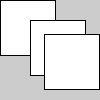translate()#
Specifies an amount to displace objects within the display window.
Examples#

def setup():
py5.translate(30, 20)
py5.rect(0, 0, 55, 55)

def setup():
py5.size(100, 100, py5.P3D)
# translating in 3D requires P3D
# as the parameter to size()
# translate 30 across, 20 down, and
# 50 back, or "away" from_ the screen.
py5.translate(30, 20, -50)
py5.rect(0, 0, 55, 55)

def setup():
py5.rect(0, 0, 55, 55) # draw rect at original 0,0
py5.translate(30, 20)
py5.rect(0, 0, 55, 55) # draw rect at new 0,0
py5.translate(14, 14)
py5.rect(0, 0, 55, 55) # draw rect at new 0,0
Description#
Specifies an amount to displace objects within the display window. The x parameter specifies left/right translation, the y parameter specifies up/down translation, and the z parameter specifies translations toward/away from the screen. Using this function with the z parameter requires using P3D as a parameter in combination with size as shown in the second example.
Transformations are cumulative and apply to everything that happens after and subsequent calls to the function accumulates the effect. For example, calling translate(50, 0) and then translate(20, 0) is the same as translate(70, 0). If translate() is called within draw(), the transformation is reset when the loop begins again. This function can be further controlled by using push_matrix() and pop_matrix().
Underlying Processing method: translate
Signatures#
translate(
x: float, # left/right translation
y: float, # up/down translation
/,
) -> None
translate(
x: float, # left/right translation
y: float, # up/down translation
z: float, # forward/backward translation
/,
) -> None
Updated on March 06, 2023 02:49:26am UTC
